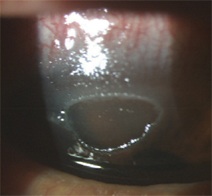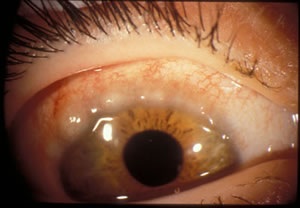|
Vernal Conjunctivitis
Have you suffered from profound itching of the eyes, photophobia (sensitivity to light), tearing, and mucus discharge from the eyes? Do your symptoms keep coming back, especially during certain seasons? Do you live in a warm climate? If you answered yes to most of these questions, you may have Vernal Keratoconjunctivitis (VKC) or Vernal Conjunctivitis VKC is a severe inflammation of the conjunctiva that can be associated with corneal complications. The conjunctiva is the tissue covering the white part of the eye. The cornea is the transparent tissue in front of the colored part of the eye. Because the cornea provides part of the optical power of the eye to focus, inflammation and scarring of the cornea can affect vision. V KC is seasonally recurrent bilateral inflammation of the conjunctiva. The majority of affected individuals are males under the age of 20. The average duration of VKC is four years, and most patients tend to “outgrow” the condition by age 30. The condition is more common in dry, warm climates. In more temperate climates, VKC tends to be seasonal, with symptoms increasing in the spring and decreasing in the fall.Patients with VKC tend to have a family history of allergies. What are the signs and symptoms of Vernal Conjunctivitis?
VKC tends to occur in two forms:
Corneal signs include superficial punctate keratitis (SPK), shield ulcer, and even keratoconus. SPK is marked by dryness of the cornea and small dots of positive staining when fluorescein is instilled in the eye. How can Vernal Conjunctivitis be diagnosed?
One of the main diagnostic features is the conjunctival scraping showing prominent eosinophils, many of which will be fractured, releasing their granules. These are white blood cells that trigger the allergic response seen in the condition. Tears show elevated IgE and histamine levels, which are also mediators of allergic reactions. How is VKC managed?
For milder cases, topical vasoconstrictors and antihistamines can be used to help with itching. Topical mast cell stabilizers to be used long term may be helpful in stopping the allergic reaction at its source. For the more severe cases, the mainstay of treatment has been topical steroids. However, using long term steroids, even in eye drop form, poses some potential risks for the eye. Topical steroids have been implicated in high eye pressure and cataract formation. For this reason, you must be monitored closely by an eye doctor if you are put on steroid eye drops. In efforts to calm the immune response of the eye, topical cyclosporin has also been used. |






